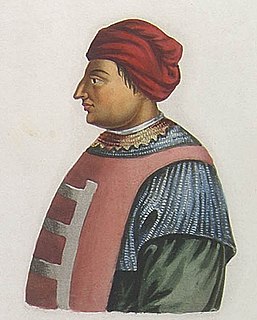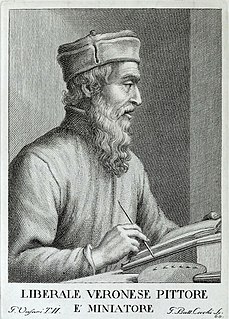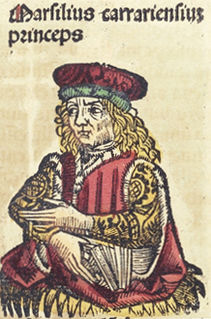Related Research Articles

ManuelChrysoloras was Greek scholar and a pioneer in the introduction of Greek literature to Western Europe during the Late Middle Ages.

Jacopo Bellini was one of the founders of the Renaissance style of painting in Venice and northern Italy. His sons Gentile and Giovanni Bellini, and his son-in-law Andrea Mantegna, were also famous painters.

Altichiero da Verona, also called Aldighieri da Zevio, was an Italian painter of the Gothic style.

Cangrandedella Scala was an Italian nobleman, belonging to the della Scala family which ruled Verona from 1308 until 1387. Now perhaps best known as the leading patron of the poet Dante Alighieri, Cangrande was in his own day chiefly acclaimed as a successful warrior and autocrat. Between becoming sole ruler of Verona in 1311 and his death in 1329 he took control of several neighbouring cities, notably Vicenza, Padua and Treviso, and came to be regarded as the leader of the Ghibelline faction in northern Italy.
Maestro Piero was an Italian composer of the late medieval era. He was one of the first composers of the Trecento who is known by name, and probably one of the oldest. He is mainly known for his madrigals.

Castelvecchio Museum is a museum in Verona, northern Italy, located in the eponymous medieval castle. Restoration by the architect Carlo Scarpa between 1959 and 1973 has enhanced the appearance of the building and exhibits. Scarpa's architectural style is visible in the details for doorways, staircases, furnishings, and even fixtures designed to hold a specific piece of artwork. The renovation carefully balanced new and old, revealing the history of the original building where appropriate. Unusual at the time, this approach has now become a common approach to renovation.

Mastino II della Scala was lord of Verona. He was a member of the famous Scaliger family of northern Italy.

The Carraresi (or da Carrara) were an important family of northern Italy in the 12th to 15th centuries. The family held the title of Signori of Padua from 1318 to 1405.

Jacopo d'Avanzi was an Italian painter of the Renaissance period. He is also known as Jacopo Avanzi or Jacopo de Avanzi, although apparently often confused with other artists, including Jacopo de' Bavozi and the Vicentine Avanzo.

Liberale da Verona (1441–1526) was an Italian painter of the Renaissance period, active mainly in Verona.

The Lives of the Most Excellent Painters, Sculptors, and Architects, often simply known as The Lives, is a series of artist biographies written by 16th-century Italian painter and architect Giorgio Vasari, which is considered "perhaps the most famous, and even today the most-read work of the older literature of art", "some of the Italian Renaissance's most influential writing on art", and "the first important book on art history".

Marsilio da Carrara was Lord of Padua after his uncle Jacopo I. He was a member of the Carraresi family.
Jacopo or Giacomo I da Carrara, called the Great (Grande), was the founder of the Carraresi dynasty that ruled Padua from 1318 to 1405. He governed with the advice of the leading citizens during a rule characterized by unity within the city. He is usually considered the first lord (signore) of Padua, his election marking the transition from commune ad singularem dominum, a characteristic regime known as a signoria to contemporaries.
Jacopo Avanzo of Verona, has long been confused with Jacopo degli Avanzi of Bologna; but the remains of an inscription in the Cappella San Giorgio point to Verona as the birthplace of Avanzo. He painted decorations, in conjunction with Altichiero da Zevio, in the Cappella San Felice and the Cappella San Giorgio in the church of Sant' Antonio at Padua, in 1377. It appears that the principal frescoes in the Cappella San Felice were the work of Altichiero; and of those in the Cappella San Giorgio, which were recovered from oblivion in 1837 by Dr. E. Förster, the part to be assigned to Altichiero has given rise to much dispute; but it is thought by some authorities that Avanzo executed the principal portion. The frescoes represent the earlier part of the 'History of our Lord,' the 'Coronation of the Virgin,' the 'Crucifixion,' and 'Legends of St. George, St. Catharine, and St. Lucy.' They prove the painter to have been an artist of no common genius, and Kugler, in his description of them, speaks of his art as being above that of his contemporaries. Avanzo also painted two triumphal processions in a public hall of Verona, which have long since perished. He died about the end of the 14th century.
Jacopo Alighieri (1289–1348) was an Italian poet, the son of Dante Alighieri, whom he followed in his exile. Jacopo's most famous work is his sixty-chapter Dottrinale.

Jacopo Sala is an Italian footballer who plays as a central midfielder for Serie A club Spezia.
Sebeto da Verona is a late 14th-century Italian painter, active in both Verona and Padua. Little is known about his biography. The name Sebeto is first bandied by Giorgio Vasari in his Lives of the Painters, however some sources claim the name is derived from De Jebeto, a vulgarization of da Zevio. They claim that such a painter was a pupil of either Francesco Squarcione or Liberale da Verona.

The San Michele Oratory or Oratory of San Michele is an oratory chapel in Padova, Italy. The interior is painted with a cycle of frescoes on the life of the Virgin Mary by Jacopo da Verona.
Simone Tronchin is an Italian football player. He plays for Virtus Verona on loan from Vicenza.